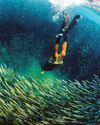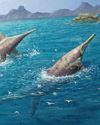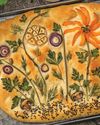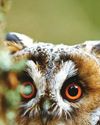
AIthough Earth is our familiar home, it is also a weird and wonderful place. And the more we learn about the bizarre creatures we share it with, the weirder and more wondrous it becomes.
Are there really spiders who cook their own supper? Marine animals with exploding backsides? Caterpillars disguised as poo, or beetles that look like mini JCBS? Amazingly, the answer is yes.
Long and short of it
Let's start with those beetles. They are called giraffe weevils and live only in Madagascar (where, by the way, many of the local animals, including lemurs, have evolved to look unlike anything else on the planet). Scientists know of more than 400,000 species of beetle so far a staggering number, yet none of the others have necks quite like these red and black beauties. In male giraffe weevils, their jointed necks stretch so far that their tiny heads are four times taller than the rest of their bodies. You can see how they got their name, but what are those magnificent necks for? The answer is fighting. Rival male weevils neck-wrestle to impress females and win the chance to mate. By a curious coincidence, actual giraffes do the same thing! What about female weevils? Their necks are far shorter and they use them for rolling leaves to make their nests.
Other animals use their body parts to help them adapt to their environment. Russia's saiga antelope has a nose so huge and droopy, it is almost a trunk. It looks a bit odd, but is ideal for life in dusty plains, since it filters dirt from the air. The antelope's massive hooter also heats up incoming air when it is cold, and helps cool air when it is hot, ensuring that the animal is always comfortable.
One of a kind
In every habitat, there are animals with adaptations that at first seem peculiar, but which actually make complete sense.
This story is from the Issue 67 edition of The Week Junior Science+Nature UK.
Start your 7-day Magzter GOLD free trial to access thousands of curated premium stories, and 8,500+ magazines and newspapers.
Already a subscriber ? Sign In
This story is from the Issue 67 edition of The Week Junior Science+Nature UK.
Start your 7-day Magzter GOLD free trial to access thousands of curated premium stories, and 8,500+ magazines and newspapers.
Already a subscriber? Sign In

What happens to the ocean if we take out all the fish?
Find out about the vital role fish play in sea life.

Cleopatra's lost tomb
You told us that historical mysteries capture your imaginations, so here's an ancient Egyptian riddle.

Kate Speller
For our readers' issue, we met a zookeeper who works with big cats.

Voyager 1 turns back on
At more than 15 billion miles from Earth, the Voyager 1 spacecraft is the most distant human-made object in space.

Orangutan uses plants to heal wound
For the first time ever, a wild animal has been observed healing a wound using a plant as medicine.

Mammoth marine reptile found on UK beach
Scientists believe the ichthyosaur could be the largest ever found.

THE LAB
Three things to make and do

The brains between the sticks
Is it true that goalkeepers see the world differently?

ALIEN HUNTERS
JD Savage blasts off on an out-of-this world quest to find life beyond Earth's borders.

NATURE IN FOCUS
Join in with Science+Nature's trail at Cheltenham Science Festival.